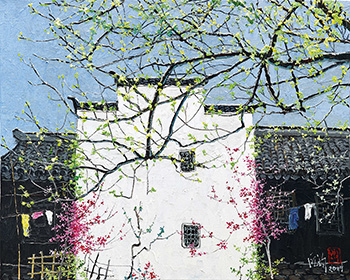Catalogue Note:
Pang Jiun once said that “Colors are emotions”, there are no certain rules, but one must have a well-rounded considerations of such factors: the subject, environment, and lightings, in addition to emotions, in order for one to see the world with objectivity and subjectivity. Pang Jiun has incorporated the Zen philosophy of “emptiness” in his works, in the sense that he unites the heart and nature, expressing a much wider and liberated aura.
The painting Spring in Huizhou is one of Pang Jiun's more recent masterpieces. The scene portrays a sense of vitality through mature brush strokes, simple colors, and the bold and ingenious use of black, white, gray as the base tones. Then paired with gentle and elegant warm palettes to form a harmonious whole to express the energy and vitality of spring. The background of the painting is made up of black roof tiles, chalk white walls, and horse-head eaves that represent Huizhou style architecture; the flowering peach blossoms in the foreground are like curtains opening on to a scene of spring. The simple elegance of the residence's white wall and dark roof tiles is depicted by the artist through using different shades of gray to create the light beige or plaster white walls of ancient Chinese architecture. The roof is a deep gray, nearly black. Under the bright blue sky, the trees are a somber green, the clothes drying under the tree in front of the house adds a homey touch to the overall scene. The purposeful blank spaces balance out the painting's color palette. The blue tiled roof and white walls of Huizhou style architecture are depicted by the artist with black and white lines, simplistic composition, and gentle use of color. This is not only in honor of his ancestors, but also an homage to Chinese cultural traditions.
The painting Spring in Huizhou is one of Pang Jiun's more recent masterpieces. The scene portrays a sense of vitality through mature brush strokes, simple colors, and the bold and ingenious use of black, white, gray as the base tones. Then paired with gentle and elegant warm palettes to form a harmonious whole to express the energy and vitality of spring. The background of the painting is made up of black roof tiles, chalk white walls, and horse-head eaves that represent Huizhou style architecture; the flowering peach blossoms in the foreground are like curtains opening on to a scene of spring. The simple elegance of the residence's white wall and dark roof tiles is depicted by the artist through using different shades of gray to create the light beige or plaster white walls of ancient Chinese architecture. The roof is a deep gray, nearly black. Under the bright blue sky, the trees are a somber green, the clothes drying under the tree in front of the house adds a homey touch to the overall scene. The purposeful blank spaces balance out the painting's color palette. The blue tiled roof and white walls of Huizhou style architecture are depicted by the artist with black and white lines, simplistic composition, and gentle use of color. This is not only in honor of his ancestors, but also an homage to Chinese cultural traditions.
